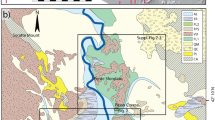Abstract
A BRIEF report by V. I. Vlodavetz on the activity of the volcanological station of Kamchatka (Bull. Acad. Soi. URSS., Sér. Géol., No. 1, 40; 1945) provides some interesting information regarding this little-known volcanic region. About 40 per cent of the total surface of Kamchatka is occupied by Quaternary and Recent lavas and tuffs, and at the present time the total number of known volcanoes is 129, of which twenty are either active or dormant. There are also sixty-eight groups of thermal springs and seventeen large geysers. The volcanoes are arranged along two belts, one extending 700 km. along the eastern margin of the peninsula, the other along the middle ridge. The most prominent active volcano is Klyuchevskaya Sopka, which during the last two hundred and forty years has erupted fifty times.
This is a preview of subscription content, access via your institution
Access options
Subscribe to this journal
Receive 51 print issues and online access
$199.00 per year
only $3.90 per issue
Buy this article
- Purchase on Springer Link
- Instant access to full article PDF
Prices may be subject to local taxes which are calculated during checkout
Similar content being viewed by others
Rights and permissions
About this article
Cite this article
TOMKEIEFF, S. Volcanological Station of Kamchatka. Nature 156, 640–641 (1945). https://doi.org/10.1038/156640a0
Issue Date:
DOI: https://doi.org/10.1038/156640a0
Comments
By submitting a comment you agree to abide by our Terms and Community Guidelines. If you find something abusive or that does not comply with our terms or guidelines please flag it as inappropriate.



